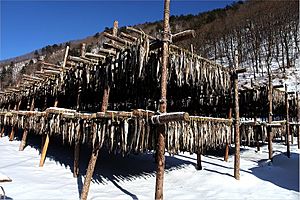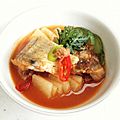Alaska pollock as food facts for kids
Alaska pollock (Gadus chalcogrammus) is a type of cod fish found in the North Pacific Ocean. It's a very popular fish eaten all over the world. Compared to other types of pollock, Alaska pollock has a milder taste, is whiter in color, and has less oil.
Many fish products you see in stores are made from Alaska pollock. Its fillets are often frozen into large blocks. These blocks are then used to make things like fish sticks or breaded fish portions. If you've ever had a fish sandwich at a fast food restaurant, like the McDonald's Filet-O-Fish, it was probably made with Alaska pollock!
This fish is also used to make surimi. Surimi is a paste made from fish meat, often used to create imitation crab meat or other seafood products. Alaska pollock is great for surimi because its flesh is very strong when processed.
Contents
History of Alaska Pollock
People in Korea have been eating pollock for a very long time, even since the Joseon era (which was from 1392 to 1897). One of the first times it was mentioned in writing was in a royal diary from 1652.
In 1940, Alaska pollock was the most commonly caught fish in Korea. Fishermen brought in over 270,000 tonnes of it from the Sea of Japan. However, by 2016, people in South Korea were eating less of it, about 260,000 tonnes per year. Much of the pollock eaten in South Korea now comes from Russia, partly because ocean temperatures have changed.
Alaska pollock is a huge fishing resource. It makes up about 32% of all fish caught in the United States and 58% of fish caught in Alaska. This fish is important for many fisheries around the world, making up about 5% of the total global fish catch.
How Alaska Pollock is Processed
After being caught, Alaska pollock fillets are carefully placed into block molds and then deep-frozen. This helps keep them fresh for shipping. For the best quality products, the fish is only frozen once, from the time it's caught until it reaches your plate. For less expensive products like fish sticks, sometimes pieces that have been frozen twice or minced (finely chopped) fish are used.
Alaska Pollock in Fast Food
Alaska pollock is a favorite in the fast food world. You can find it in popular items like the McDonald's Filet-O-Fish sandwich, Arby's Classic Fish sandwich, and Long John Silver's Baja Fish Taco. It's also used in Birds Eye's Fish Fingers. Companies like Trident Seafoods and people like Chuck Bundrant helped make this fish popular in the U.S. in the 1980s. Before that, it was mostly eaten in Asia.
Alaska Pollock in Korea
Alaska pollock is so important in Korea that it's considered the country's national fish! Its Korean name is myeongtae (명태). This name has even spread to nearby countries. In Russia, it's called mintay (минтай). In Japan, the roe (fish eggs) is called mentai-ko (明太子), even though the fish itself is called suketōdara (介党鱈).
In Korea, myeongtae has over 30 different names! These names often describe how the fish is prepared or its age:
- saengtae (생태) – This means fresh Alaska pollock.
- dongtae (동태) – This is frozen Alaska pollock.
- bugeo (북어) – This is dried Alaska pollock.
- hwangtae (황태) – This is "yellow" Alaska pollock, dried in a special way.
- nogari (노가리) – This is dried young Alaska pollock.
- kodari (코다리) – This is "nosed" young Alaska pollock, half-dried.
Koreans use every part of the myeongtae, including its insides and its roe (eggs), in their cooking.
- changnan (창난) – These are the Alaska pollock intestines.
- myeongnan (명난) – These are the Alaska pollock roe.
Fresh Alaska Pollock (Saengtae)
Saengtae (생태), which is fresh Alaska pollock, is often used to make a clear soup called saengtae-tang. This soup is usually made with radish in a broth of kelp and anchovies. Another popular dish is myeongate-jeon, which is a pan-fried Alaska pollock patty. Fresh myeongtae can also be eaten raw as hoe, which is often marinated.
Koreans also make fermented foods from saengtae. For example, myeongtae-sikhae is made by fermenting the whole fish with malt and rice. The intestines (changnan) and roe (myeongnan) are salted to make jeotgal, called changnan-jeot and myeongnan-jeot respectively.
Frozen Alaska Pollock (Dongtae)
Dongtae (동태), which is frozen Alaska pollock, is commonly used in a spicy stew called dongtae-jigae. It can also be cleaned and stuffed with vegetables to make a type of sausage called dongtae-sundae.
Dried Alaska Pollock (Bugeo)
Bugeo (북어), which is dried Alaska pollock, is often boiled in water from rinsing rice to make a clear soup called bugeo-guk. The dried head of Alaska pollock, called bugeo-daegari, is a common ingredient for making broth in Korean cooking. Other dishes made from bugeo include bugeo-jeok (skewered fish), bugeo-jangajji (pickled fish), bugeo-jeon (pan-fried), and bugeo-jorim (simmered). There's even a dish called bugeo-bopuragi, which is like "fish lint" made by grating dried pollock and seasoning it.
Bugeo can also be thinly sliced, seasoned, and dried to make fish jerky, called bugeo-po. This jerky can be eaten by itself or used in other side dishes.
Yellow Alaska Pollock (Hwangtae)
Hwangtae (황태), or yellow Alaska pollock, is made by drying the fish during winter. It goes through natural freeze-thaw cycles, which gives it a unique yellow color. It's often boiled into a soup called hwangtae-haejang-guk. Once rehydrated, hwangtae can be grilled (often with a spicy gochujang sauce) as hwangtae-gui, simmered as hwangtae-jjim or jorim, or added to rice porridge called hwangtae-juk. Jerky made from yellow Alaska pollock is called hwangtae-po.
Dried Young Alaska Pollock (Nogari)
Nogari (노가리), which is dried young Alaska pollock, is often served with different dipping sauces as a snack with drinks, known as anju.
Half-Dried Young Alaska Pollock (Kodari)
Kodari (코다리), also called the "nosed" variant, is made by cleaning young Alaska pollock and half-drying them on ropes tied through their noses. It's often simmered with radish to make kodari-jorim.
Alaska Pollock Roe
Alaska pollock roe (fish eggs) is a popular food ingredient in Japan, Korea, and Russia. In Korea, the roe is traditionally called myeongnan (명란), and the salted version is called myeongnan-jeot (명란젓).
The roe became popular in Japan after World War II. There, it's called mentaiko (明太子). A milder, less spicy version is known as tarako (鱈子). In Russia, Alaska pollock roe is sold in cans, often mixed with oil, which gives it a soft, paste-like texture.
Images for kids
-
Myeongtae-jorim (simmered Alaska pollock)
-
Myeongtae-jeon (pan-fried Alaska pollock)
-
Saengseon-gaseu (Alaska pollock cutlet)
-
Changnan-jeot (salted Alaska pollock intestines)
-
Myeongnan-jeot (salted Alaska pollock roe)
-
Dongtae-jjigae (frozen Alaska pollock stew)
-
Dongtae-jeon (pan-fried frozen Alaska pollock)
-
Bugeo-po (Alaska pollock jerky)
-
Bugeo-po-jorim (simmered Alaska pollock jerkey)
-
Bugeo-guk (dried Alaska pollock soup)
-
Hwangtae-gui (grilled yellow-dried Alaska pollock)
-
Hwangtae-haejang-guk (yellow-dried Alaska pollock soup)
-
Nogari served as anju
-
Kodari-jorim (simmered 'nosed' Alaska pollock)
















